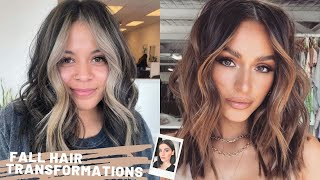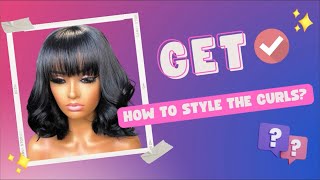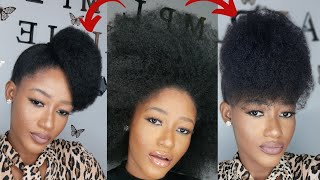Hair Weaving & Highlighting Techniques
- Posted on 14 April, 2012
- Sew-In Hair Extensions
- By Anonymous
Tom Dispenza shares important basic step-by-step Hair Weave Foil Techniques as well as a Double Weave Foil Technique, the Bold Weave Technique, a Horseshoe Foil Technique, a Balayage Technique, Ombre and a Slicing Technique.
This is your basic weaving technique. Before you weave the first section of hair for the foil, you leave a section out reason. You now have a weave at the top of the foil, not just a straight line. We come in. We weave the first section to go into the foil uneven. You do not want if eclis woven strands of hair, you want it to be unevenly woven place. Your foil begin by applying the color or the lightener knot to the edge of the foil, but down a bit. Then, when you get most of the product off of your brush, then you come back and go to the top of the foil. You won't get any bleeding this way onto the scalp area and then fold your foil twice. If it's long hair - and you only fold one section - one edge of the foil, not both of them - you hold this out of the way you now do not take a slice in between the foil instead take a weave between the foils. You can see that this now gives you that woven pattern both on the top and the bottom of the foil. Come back, take another section and place your next foil and proceed for the double woven foil. You start with the basic weave technique. Now, when you weave the second section that normally would be left out of the foil, you now include it in another foil back to back. This second foil is done with a second color or a different strength. Lightner now you leave a section out and leave it in between the effect of the double weave. Foil. Is this when you open the foil and remove the product from the hair, because you've woven back-to-back foils, you can see that the two shades intermix perfectly and it appears, is that you have dark light, dark light, dark light, dark light. That'S the function of a double weave, foil for the bold leaf you take a very heavy weave section heavier than you normally would place. Your foil now take a very, very fine section of here in a light slice very, very finely sliced place it in between the two foils. Now do another heavy weave place that in the second form, with you, a light move or color product. Take another very fine section of hair in between out of the way and take a third, bold weave. The effect of these three foils that are almost back to back, except for just a few fine hairs in between, is to give you a very bold and pronounced effect in the hair. Generally, it's reserved for the front of the hair or for some very special area. They have the very fine pieces that you left out simply add more dimension to the part that has been highlighted and make it appear even brighter and lighter than it is a very avant-garde and special highlighting technique is called the horseshoe. The horseshoe runs from halfway between the eye and the top of the eyebrow. You take a point. That'S halfway between them. You isolate all the hair. Above it you can see. The horseshoe shape goes completely around the head, starting from halfway between the eye in the top of the eyebrow and proceeding to the same position on the other side of the hair. Going all the way around. This top section does not receive any color you're going to use two back-to-back foils, very heavily, woven with a very, very fine piece in between the two of them. Once again, that very fine section in between the two gives you a dimensional effect to your horseshoe, highlights out of the way you take the second heavy weave you have now. What is basically, two coils that are back-to-back with this very tiny piece of dimensional hair in between back-to-back with a tiny piece of hair in between this horseshoe runs continuously all the way around, with no breaks anywhere between the foils. This gives you an effect when the client, with this technique in her hair shakes or moves her hair you'll, be able to see that hidden horseshoe of color, so movement brings the highlight to the surface or you get a glimpse of it strictly for the avant-garde. A balayage and an ombre technique are very similar, the difference being in the size of the section that you're going to highlight and number two, the closeness to the scalp, we'll start with a balayage. You take the section of hair to be Valley. Ashed generally, it's a quarter to one half inch section that is square quarter to one half inch section that is squared. You use a valley ash stick, which is nothing more than a piece of wood, I'm using a painters stirrer, I'm using the stick that you received from the paint shop for stirring a gallon of paint. You apply a little bit of your product to hold the hair in place. You then place the hair on the stick and hold it with balayage. You get very close, but only a tiny piece of it to the scalp very close, but tiny piece. You then do more of a section coming down and then the entire section at the tips. So it's finer a little bit heavier very heavy right on the scalp. You then gently remove the stick from the hair and let it settle into place. You place these in rows, starting at the bottom working your way up, one two, three four rolls generally and then a couple extra ones at the top same thing. On the other side doing this technique, you start generally at the cheek and do a section one. Two three: four: five: six as many as you want the second, then you gently let a section of hair down and do the second one about halfway in between the eye and the growl. 1. 2. 3. 4 same thing same way, then you come to the top and you do the you do a third one, basically you're doing a horseshoe technique except you're, not doing it solid and back-to-back you're doing using the you're using the stick to give individual highlights if you're afraid That it's going to motion to the other hair, then after you do a section all the way around gently clip a piece of saran wrap over that hair, clip it and then drop the next section down on top do the same procedure. Every technique is a little different. You take the section, a much larger section about 3/4 to an inch wide where you want. The big hombre highlight to look in the hair. This time you do not, you do not need to stick, you can use it. If you want, but you do not need to sit this time, you do the same thing about about a third of the way off of the scalp. You start with a little bit on one edge. Then you go a little bit more as you get further away, and then you do the entire section. It heavily slicing technique. When you're going to highlight the hair using slicing technique. You take a spine section so that you can see through it and it appears to be a highlight, even though it's a straight slice, you've done it. So, finally, it appears as a highlight in the air. You then weave or slice the section out. That'S a little bit heavier than what you've already done, heavier section woven out, and then you do your second slice right. The lower your second slice once again, a fine slice that mimics a weave pattern. You





Comments
fear not: Your tutorial is very helpful Thank you very much
Robin Fox: Interesting technique. A pity it goes against what we're tested for in beauty school.
Belle Merc: Excellent technique, excellent teaching! One thing I would ask and many forget this, PLEASE SPEAK LOUDER! Super video! Thanks much.
Hair colorist Martin Rodriguez: Hi Tom which is the video where you mix the extra light creams and bleach for extra blonding?
RyanUnfinished: Is there a reason to do it on wet hair?
Shree: I really like your video Sir✔️